




Join











Join








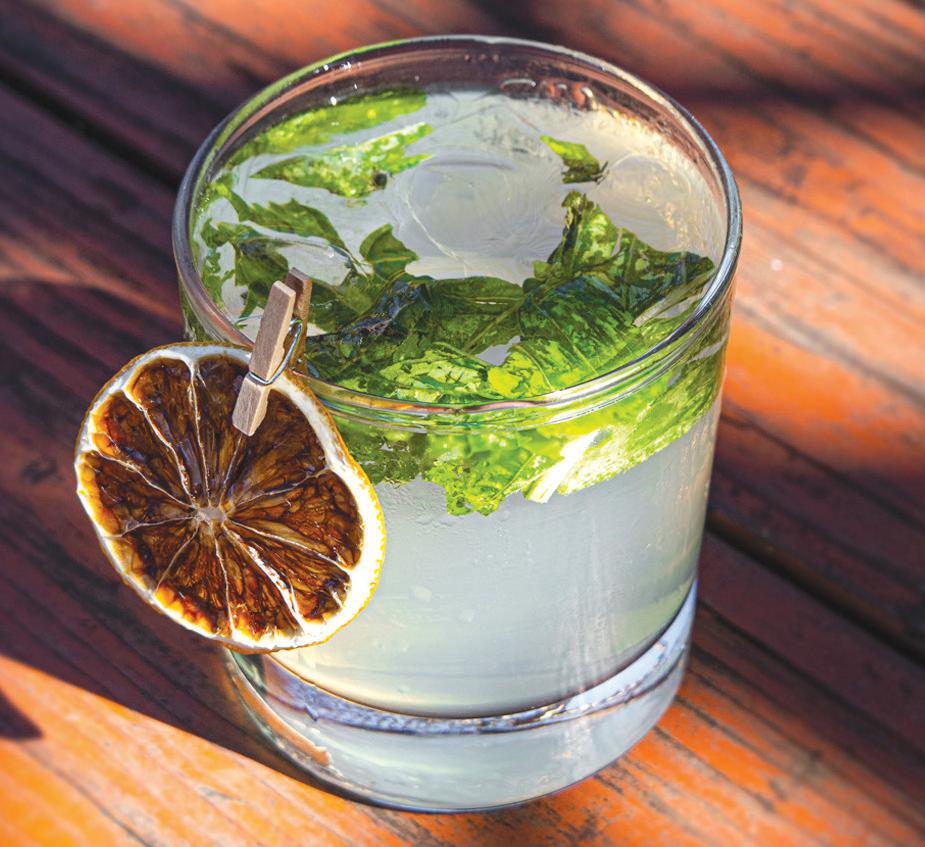
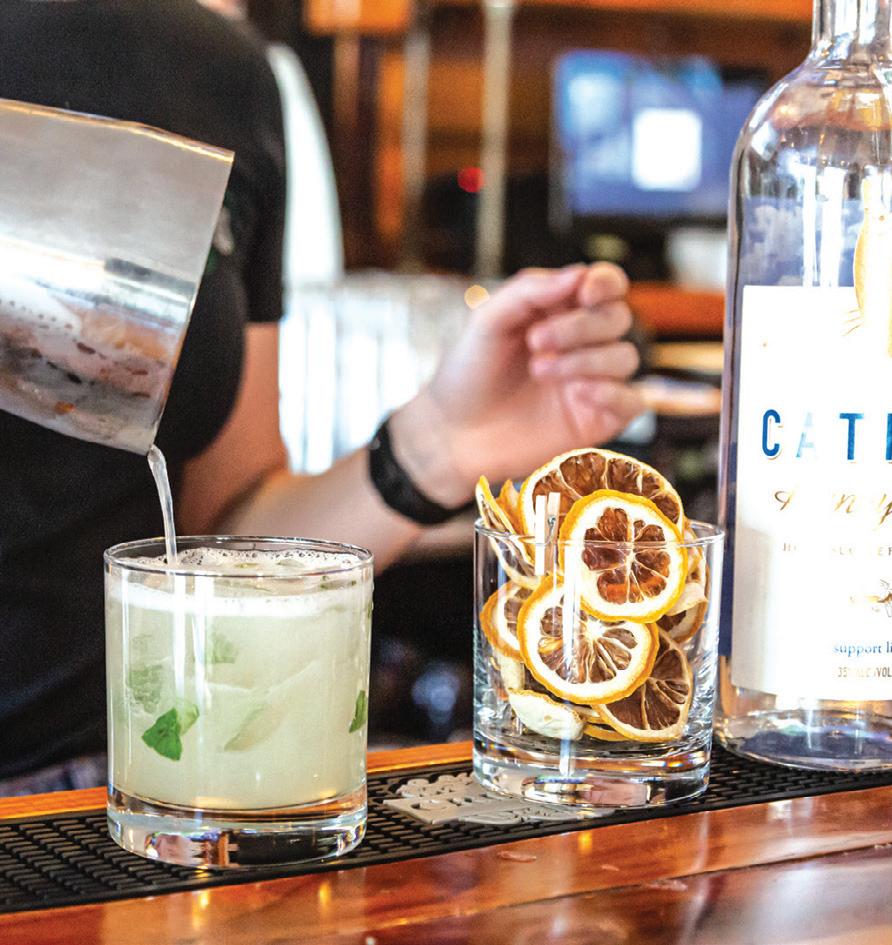
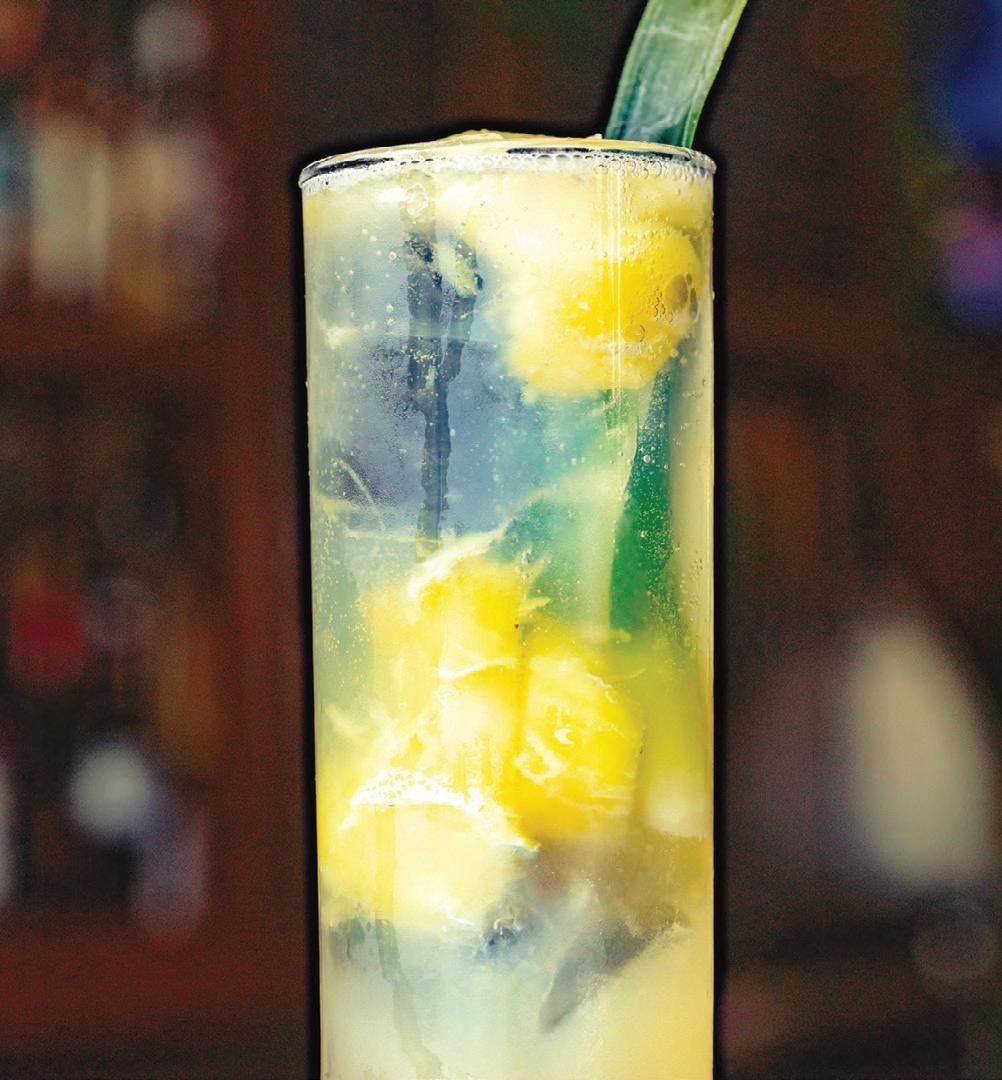
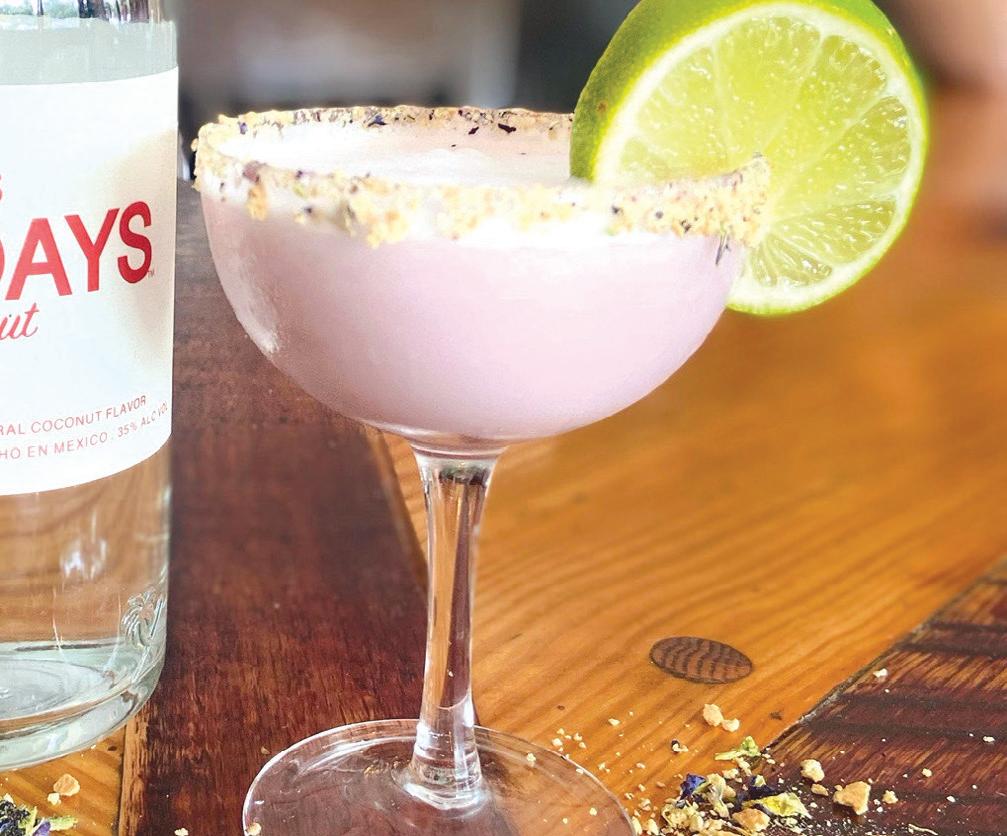



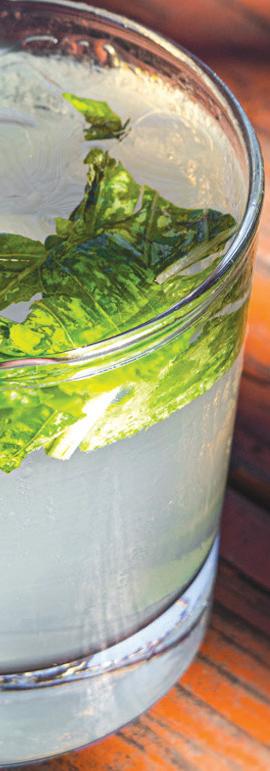




Raise a glass for another year of Swig, The City Paper’s bar guide. In this year’s issue, we’re beating the heat and gearing up for fall with recipes for six classic cocktails. Whether you’re interested in whipping up your own Vesper martini at home or looking for the next best place to sip a Manhattan, we’ve got you covered. Plus, learn more about Charleston’s expanding distillery scene and how to pick the perfect summer wines. Cheers, y’all!
Samantha Connors
Area bartenders share tips, recipes for classic cocktails
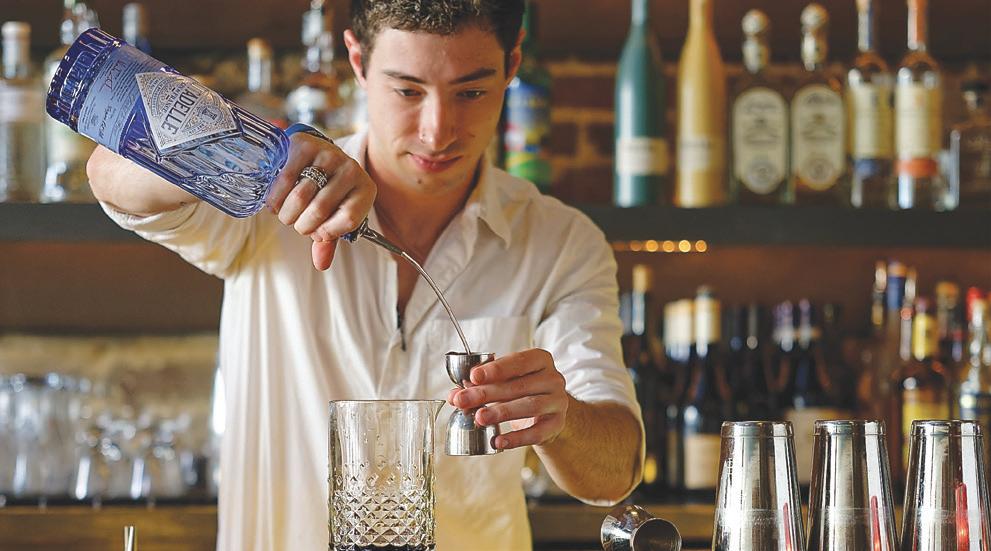
How Zest Vodka was built from rum

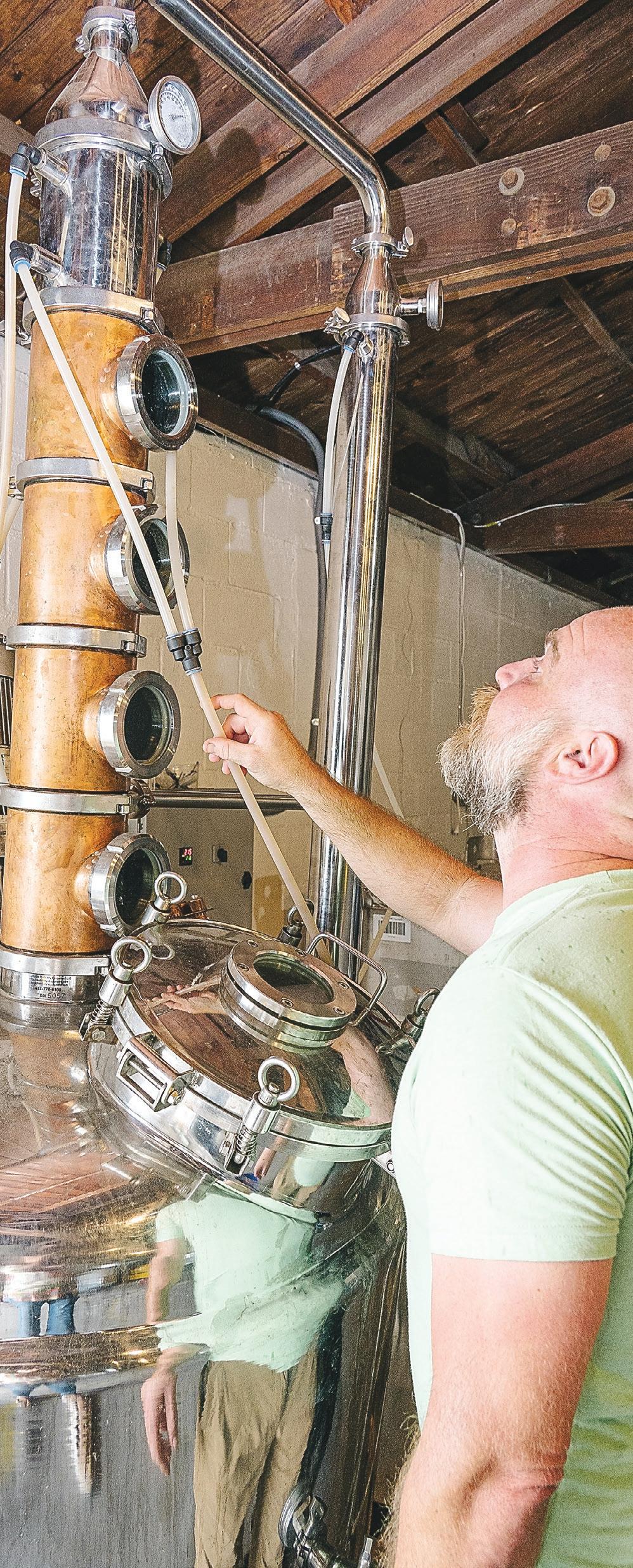
Sommelier and general manager of The Royal Tern shares tips for selecting summer wines
Andy Brack
Cris Temples
MANAGING EDITOR: Samantha Connors
NEWS:
Skyler Baldwin, Herb Frazier, Chelsea Grinstead, Chloe Hogan, Hillary Reaves
CONTRIBUTORS:
Amethyst Ganaway, Michael Pham, Tiare Solis
ADVERTISING DIRECTOR: Cris Temples
ACCOUNT EXECUTIVES:
Aynsley Barnett
Kristin Byars
Ashley Frantz
Mariana Robbins
Gregg Van Leuven
SALES ASSISTANT: Crystal Joyner
ART DIRECTOR: Scott Suchy
PRODUCTION DIRECTOR: Déla O’Callaghan
GRAPHIC DESIGNER: Christina Bailey
STAFF PHOTOGRAPHER: Rūta Smith
ADDITIONAL PHOTGOGRAPHY:
Steve Aycock, Ashley Rose Stanol
DISTRIBUTION
CIRCULATION TEAM: James Barron, Robert Hogg, Makena Hohl, Stephen Jenkins, David Lampley, Spencer Martin, John Melnick, Tashana Remsburg
PUBLISHED BY CITY PAPER PUBLISHING, LLC


Swig is a publication of the Charleston City Paper and is published once a year by City Paper Publishing, LLC. All content is copyrighted and the property of City Paper Publishing, LLC
Charleston City Paper
P.O. Box 21942
Charleston, S.C. 29413
(843) 577-5304
charlestoncitypaper.com
The Summer Lover at Sweet Grass Lounge. Photo by Rūta Smith. proud member
Husk’s dragoon rum punch
Area bartenders share tips, recipes for classic cocktails Rūta

just think it’s magic.
But mastering the craft of mixing your favorite cocktail at home is not as difficult as you might think. Of course, every bartender has their own tips and tricks they utilize to make their creation stand out. This is probably why you have a favorite cocktail at a specific bar — the bartender’s notable technique.
Here, we highlight some popular and lesser-known concoctions with expert advice on how to shake (or stir) your own at home.
Though the history of the drink is contested, as the most popular legend goes, Count Camillo Negroni created an instant classic when asking for an Americano with the soda swapped for gin in Florence, Italy, 1919. One part gin, one part vermouth and one part Campari. That, plus an orange peel for garnish, is all you need to make this red-hued, classic Italian cocktail.

The Belmont on King Street is a great place to sip a Negroni and enjoy a black and white film on its projector screen. (Perhaps you’ll even catch a film where the drink is featured, like the 1961 British romantic drama The Roman Spring of Mrs. Stone .)
Served on a rock of ice in an old-fashioned glass, the cocktail’s first taste is focused on the vermouth and the subtle smell of citrus from the orange peel. The flavor of gin is left lingering on the tongue.
During the dark days of Prohibition, gin was among the era’s most popular spirits, in part because its potent juniper oils could help mask the strong taste of diluted industrial alcohol.
The Negroni is a drink which F. Scott Fitzgerald’s contemporaries and characters would have been sipping (though a gin rickey is reported to have been Fitzgerald’s favorite).
Who drinks a Negroni? “A smart drinker, a seasoned drinker,” said Tristin Bisesi, The Belmont bar manager and a mixologist with 10 years of experience under his belt.

“The body of the cocktail comes through the sweet vermouth, which balances out all those slightly aggressive and floral tones in the gin. That orange expression helps exfoliate the citrus in the Campari, which creates a nice balance,” he said. “But, you still want to allow the gin to come through and shine.”
The Belmont uses Citadelle gin, for its more neutral flavor, as opposed to something like Hendricks which has notes of pine, Bisesi said. If you’re into that more piney flavor, perhaps you’d enjoy what he called an “alpine Negroni.” But there are endless variations to this cocktail.
“Of course, the true classic is gin. But there are so many ways you can do it.”

Bisesi’s personal favorite is a Kingston Negroni, in which gin is swapped for rum. The bubbly version of the drink, the Negroni sbagliato had a moment in pop culture last year, when HBO’s House of Dragon star Olivia Cooke asked her costar Emma D’Arcy, “What’s your drink of choice?”
“A Negroni,” coos D’Arcy, who uses they/them pronouns, in reply. “Sbagliato,” they continue. “With Prosecco in it.”
Stunning, indeed. Though the sbagliato is not Bisesi’s personal favorite, he said it’s a decent choice, so long as you keep
the three parts even, switching the gin for prosecco in this case.
“Sbagliato literally means ‘mistake,’” he said. “Somebody reached for a gin bottle and instead pulled up a sparkling bottle. But the mistake happened to work. That’s how a lot of cocktails are made anyway — you accidentally reach for the wrong thing, or you just say, ‘You know what? Let’s throw this in here and see how it goes.’”
For those who enjoy mixing drinks, a classic Negroni is a great place to start, Bisesi said. “It’s a three part feast, but you can change those parts out so much as long as you keep the balance.”
Chloe Hogan1 oz. gin
1 oz. Campari
1 oz. sweet vermouth
Orange peel for garnish
Add equal parts gin, Campari and sweet vermouth to a mixing glass filled with ice. Stir (don’t shake) until well-chilled. Strain into a rocks glass over a large ice cube. Garnish with an orange peel.
atch a bartender whip up a tantalizing cocktail in just a few minutes — viciously shaking shakers, delicately adding garnishes — and you mayBar manager of The Belmont Tristin Bisesi makes a classic Negroni
Crafting the perfect martini is a telltale sign of a skilled bartender. The martini is a quintessential cocktail with a nearly endless amount of possible variations.
“A classic martini is just one spirit, either vodka or gin traditionally, and always vermouth,” said Chelsey Donnahoo, bar lead at Camellias in downtown’s Hotel Bennett. “It can be a dry vermouth, a sweet vermouth. But it’s basically just a bowl of liquor.”
Though a traditional martini is pretty simple, it can be one of the more complicated drinks to order as the drinker has many options to customize the cocktail.
First, you must select your liquor of choice. For most people, this is just a matter of preference between gin and vodka.
“There are so many different types of gin,” Donnahoo said. “There’s very botanical gins. Sometimes you get the evergreen, piney taste in gin. Gin is flavorforward while vodkas, unless it’s a flavored vodka, usually all taste the same.
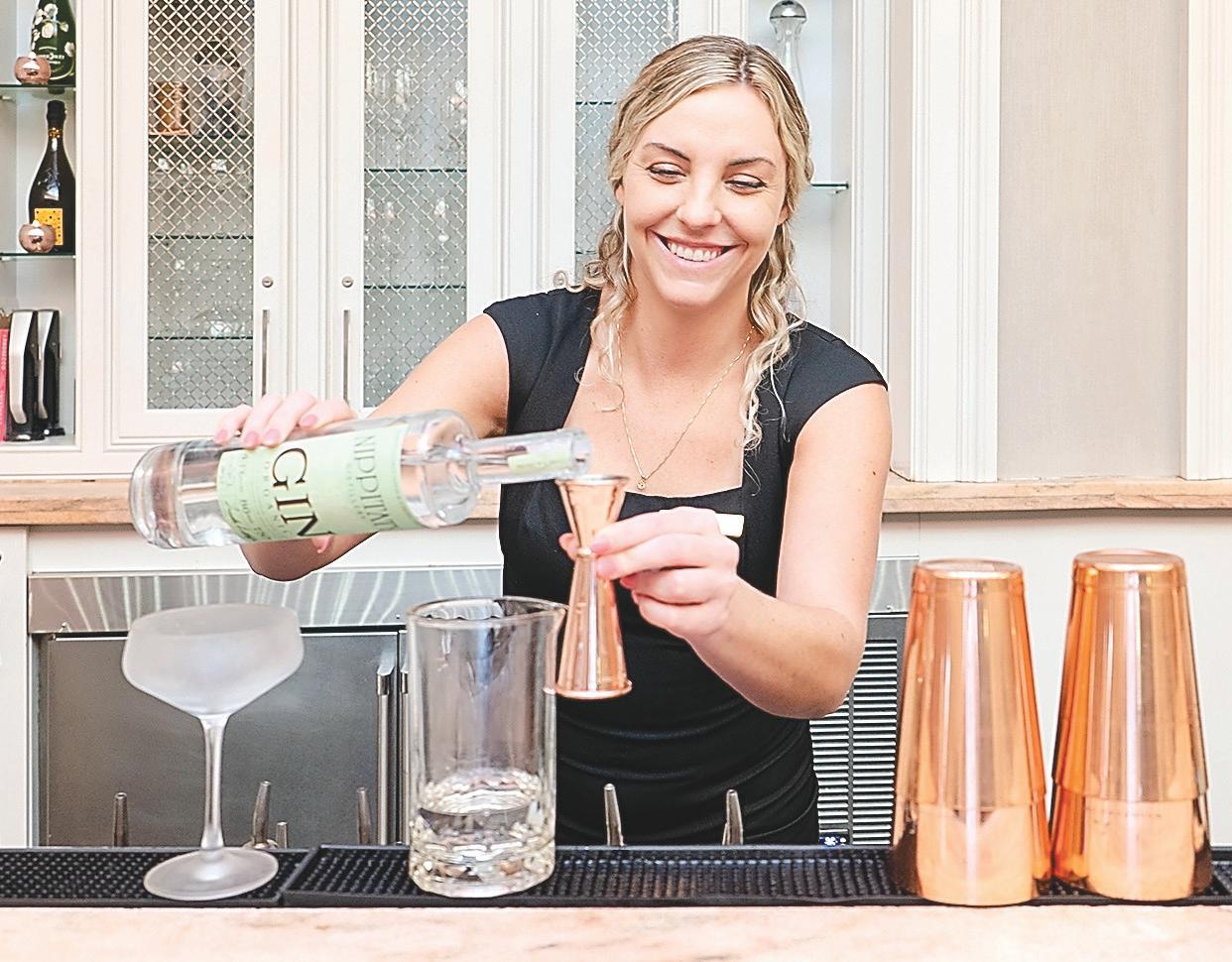
“I think people who are gin drinkers enjoy the citrus notes, the herbs, the spices. Gin adds more body and flavor to your cocktail.”
For a classic martini, Donnahoo uses local Nippitaty Distillery’s organic gin combined with a dry vermouth.
“If I was to drink a regular classic dry martini like this, I would choose gin,” she said. “If I was incorporating other aspects to it, like olive juice in a dirty martini, I would choose vodka.”
Once you’ve chosen a base, decide the vermouth-to-liquor ratio you prefer. Donnahoo’s classic martini incorporates five ounces of gin to one ounce of vermouth.
If you’d like more vermouth, order your drink “wet,” which tells a bartender to use more of this low alcohol-by-volume (ABV) fortified wine. Ordering it “dry” means less vermouth. Donnahoo said ordering a “rinse” means the bartender literally rinses the glass with a small amount of vermouth and pours it out before adding liquor.
She finished off the martini with a twist — a lemon peel garnish rubbed around the glass’s rim and added to the mixture. And a pink rose petal, the standard addition to cocktails in Camellias, which is known as the hotel’s Champagne lounge, though the bartenders serve a wide variety of creative cocktails and traditional drinks.
Other garnishes and additional options include olive juice (“dirty,” or for extra olive juice, “filthy”), sweet ver-
mouth in place of dry (“sweet”) and no garnish (“clean”).
Finally, choose your blending preference — shaken or stirred?
Donnahoo recommends shaking any time additional elements have been added, such as olive juice, but cocktails with just alcohol should be stirred, she said. Shaking can dilute a drink and also adds a cloudy appearance because oxygen is trapped in the liquid when shaken.
Despite that advice, secret agent character James Bond has long been known to prefer his martinis “shaken, not stirred.” And the fictional Bond even inspired a real-world rendition of his signature drink — the Vesper martini.
“The Vesper really became known from James Bond because he named the cocktail after his lady lover, whose name was Vesper. And now it’s a worldwide cocktail,” Donnahoo said.
A mention of this drink first appeared in author Ian Fleming’s 1953 novel Casino Royale . But the cocktail has withstood the test of time and remains a popular option for a classic, boozy cocktail.
The Vesper differs from a traditional martini because it includes both gin and vodka along with Lillet blanc, a low ABV French wine, and a lemon twist.

“A martini is the easiest cocktail to make,” Donnahoo said, “but the most complicated in the sense that it’s so specific to what a person likes.” — Samantha Connors
5 oz. Nippitaty Distillery gin
1 oz. Dolin dry vermouth
1 lemon twist for garnish
Pour into a mixing glass with ice, and stir for 30 to 45 seconds. Strain into your glass of choice. Rub the rim with inside of lemon peel garnish and top drink.
2 oz. Firefly Distillery vodka
2 oz. High Wire Distilling Co. Hat Trick gin
2 oz. Lillet blanc
1 lemon twist for garnish
For a shaken martini, all equal parts of each ingredient to a shaker with ice. Shake for at least 30 seconds. Strain into a glass of your choice, and add a lemon twist garnish around the rim. For a stirred martini, pour all alcohol ingredients into a mixing glass and stir. Strain into a glass and add a lemon twist.


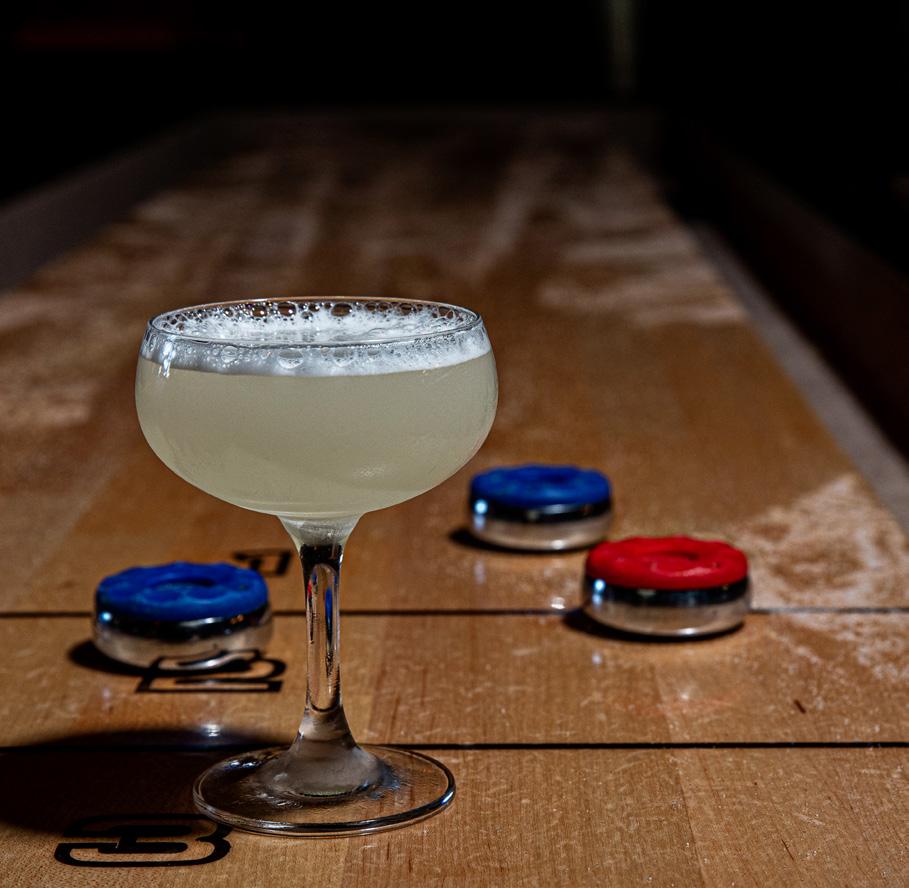
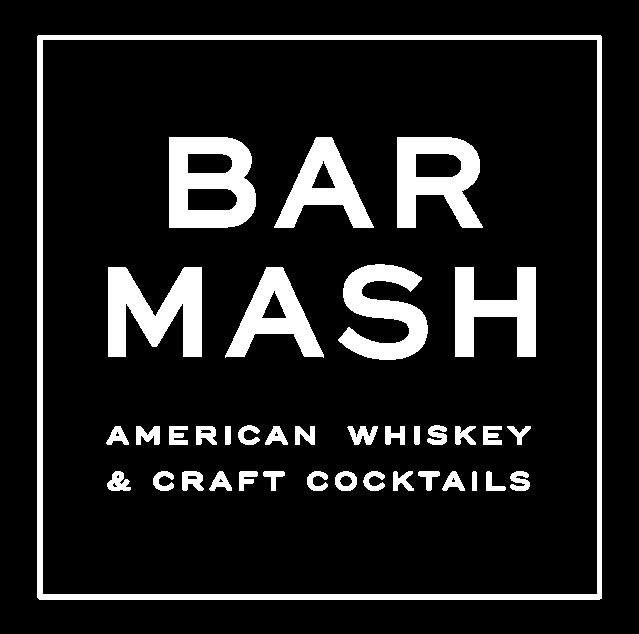


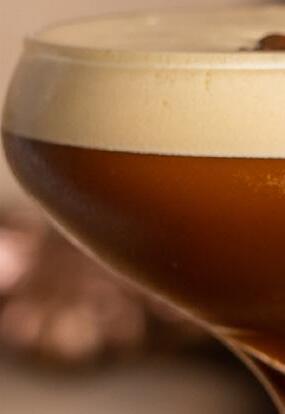

A Black Russian is a straightforward cocktail, two parts vodka and one part Kahlúa, but Miguel Buencamino, founder of Holy City Handcraft, offers a twist to this traditional recipe.
The Black Russian emerged on the global bar scene in the late 1940s in Brussels. According to lore, bartender Gustave Tops at the Hotel Metropole made the drink for America’s ambassador to Luxembourg, Perle Mesta.
The cocktail’s name is derived from the blackness of Kahlúa, a Mexican-made coffee liqueur consisting of rum, sugar and arabica coffee, and vodka that evokes thoughts of Russia.
Buencamino, a self-taught mixologist, said the Kahlúa is fine, but he offers an alternative.

“Kahlúa is an incredible ingredient, but I am partial to Mr. Black, an Australian coffee liqueur that offers a deep rich taste that is not as sweet as Kahlúa.”
Buencamino adds the unexpected. A pinch of salt.
The salt sounds odd, he admitted, but saline accentuates the flavor and rounds out the bitterness of the coffee, he explained. “You get to taste a little more of the coffee flavor and the fruitiness of the coffee beans,” Buencamino said.
Although the Black Russian is tagged with a chic name, it does not sit at the top of the cocktail popularity poll, he revealed.
The White Russian is the frontrunner because it was popularized in the 1998 crime comedy The Big Lebowski It is a Black Russian with milk and cream that softens the coffee, making it a precursor to an espresso martini, said Buencamino, a Charleston resident who wears many hats. He’s also a commercial producer, photographer and videographer.
If you don’t want to venture out on the bar scene, the Black Russian is easy to make at home. Stir the ingredients with ice, and strain the liquid into a second glass. Buencamino, however, said you can skip the mixing over ice and blend the ingredients into a whiskey glass then drop in a couple cubes.
But if you prefer to watch a bartender mix one for you, Buencamino recommends the bar at Frannie & the Fox in the Emeline where they make a good espresso martini so, by extension, they’ll offer a great Black Russian, too Herb Frazier
2 oz. vodka
1 oz. Mr. Black coffee liqueur (or Kahlúa)
Pinch of salt
Stir the ingredients with ice, and strain the liquid into a second glass.
Bourbon, sweet vermouth and bitters are essential to any Manhattan, said Melissa Cone, head bartender at Charleston Grill. While she prefers Carpano Antica Formula vermouth and Angostura bitters, Cone said Manhattan-making enthusiasts can play around with the many bitters options out there as well as switch up the star spirit.

“I do enjoy a Manhattan — a deep bourbon sweetness that calms all nerves,” Cone told the Charleston City Paper
And while there are different stories behind the invention of the classic drink, Cone favors the most popular theory, which says the Manhattan was created at The Manhattan Club by Dr. Lain Marshall
Continued on page 12
Cha s ing suns e ts a nd sippin g margari ta s a ll year l on g
Cha s ing suns e ts a nd sippin g margari ta s a ll year l on g
2205 MIDDLE ST SULLIVAN’S ISLAND 817 ST. ANDREWS BLVD CHARLESTON 1109 PARK WEST BLVD MT PLEASANT MEX1COASTALCANTINA.COM

PUMPKIN PIE? MEET THE TITO’S MARTINI.

2 OZ TITO’S HANDMADE VODKA
½ OZ HALF & HALF
1 TBSP CANNED PUMPKIN PIE MIX
(MAKE SURE IT’S CANNED PUMPKIN PIE MIX, AND NOT JUST CANNED PUMPKIN)

¹∕8 TSP VANILLA EXTRACT

1 DASH CINNAMON
Add all ingredients to a shaker with ice. Shake and double strain into a graham-cracker-rimmed martini glass. Garnish with a small amount of freshly grated nutmeg.
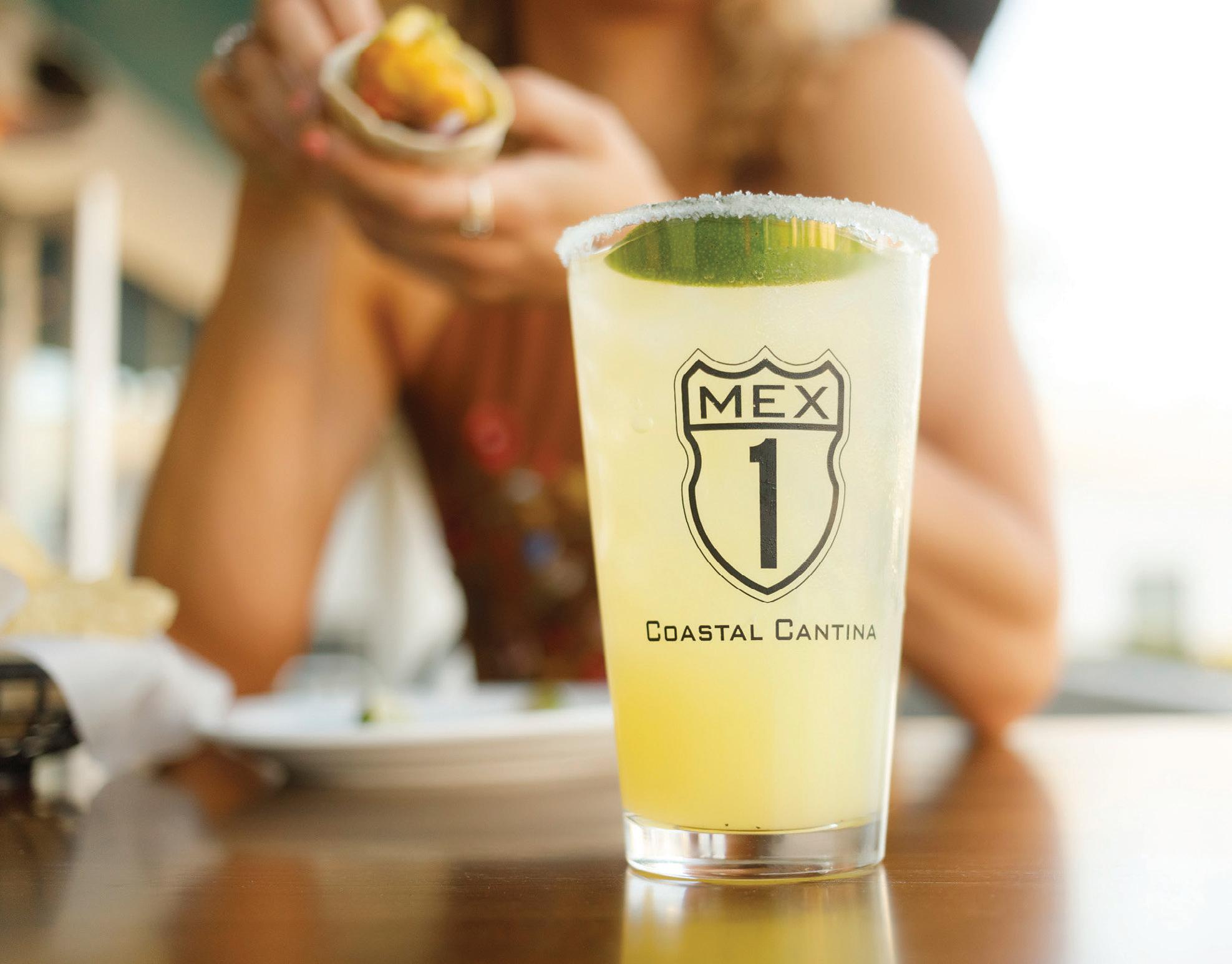
The Manhattan is a simple, classic, bourbon-forward cocktail
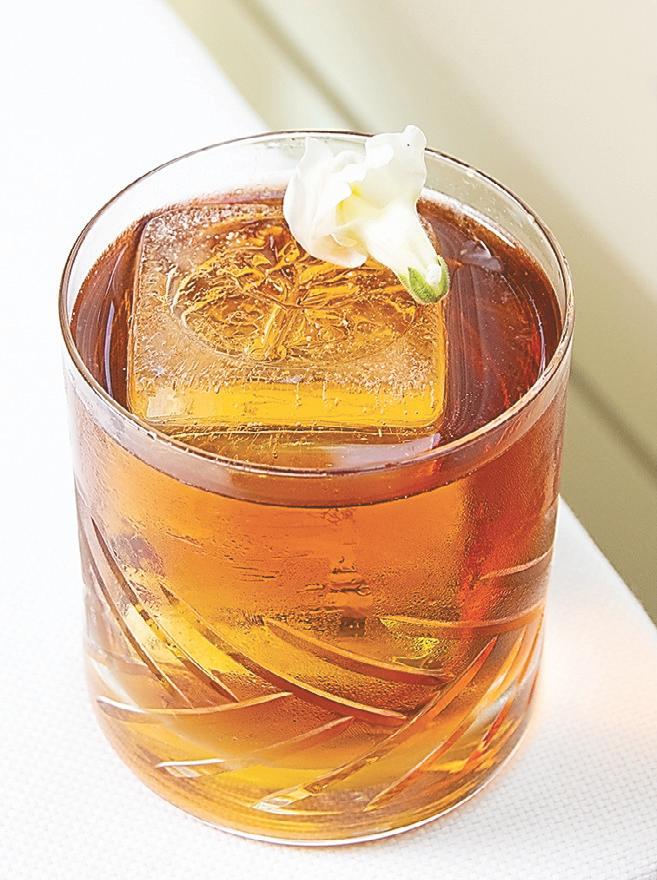
COCKTAILS continued from page 10
in the early 1800s for the mother of Winston Churchill.
For a nice summertime spin on a classic Manhattan, Cone suggests using a light Japanese whisky with a dry vermouth stirred and poured over ice with a lemon twist garnish. Charleston Grill’s riff on a classic Manhattan includes Woodford Reserve, Italian apéritif Cynar, Tempus Fugit banana liqueur, black walnut Bitters and Charleston Sercial Madeira fortified wine.
“All ingredients are stirred, poured over a large ice cube and garnished with the zest of an orange,” Cone said. “This cocktail is so smooth, with beautiful notes of walnuts and caramelized banana. The Madeira also adds a dry nutty finish.”
Cone, who has been bartending for 25 years, was raised in the world of hospitality in upstate New York, she said. Her mother, Beverly Reedy, had a restaurant and gourmet food store called Beverly’s Specialty Foods in Saratoga Springs where she worked every position in the front- and back-of-house.

“She likes to say that I quit, or she fired me once a week,” Cone said of her mom, “[which is] not totally accurate, but I was a teen. … I think back to the days at Beverly’s all of the time. My most prized memories were made there. Working so closely with my family and friends — you can’t beat that.”
Cone started at the Charleston Grill in 2019, and said her coworkers are truly like family.
“The astounding number of service experience we have all together is amazing,” she said. “Everyone from front- to back-of-house gives 100% every day.”
Chelsea Grinstead
Don’t think too hard on this, Cone said. The Manhattan is a classic jewel. Remember 212 (the area code for Manhattan in New York City).
2 oz. bourbon
1 oz. Vermouth
2 dash Angostura Bitters
Stir, pour and enjoy.
“Trust your nose,” Nippitaty Distillery’s Traxler Littlejohn said when you’re making the perfect gimlet.
The classic cocktail can be made with vodka or gin. He suggests using a flavored vodka, such as Botanica made at his North Charleston distillery, because its flavors enhance the fresh lime juice in a gimlet. The flavors in Botanica vodka include cucumber and cardamom, followed by soft notes of orange and ginger, Littlejohn said.
The drink is special, he said, because “there’s something there when you have those notes of cardamom and cucumber. They just marry so well with the vodka.”
Gins also work in gimlets, but may have flavors that don’t bring out the essence of the lime juice, he added.
“My job is to enhance your cocktail, not for the liquor to become your cocktail,” he said, noting that the perfect gimlet has balance, complexity and a smoothness of finely distilled, higher-end liquor.
“When you drink my stuff in a cocktail, the first comment that comes to your mind is ‘this is dangerous,’” he said. You don’t taste the ethanol — the harshness

of the alcohol.”
If you want to use a different vodka than Botanica, he suggested smelling samples of different vodkas at a local bar. Most bartenders will give you small samples to smell so you find one you like. They’ll all smell differently, and whatever smells good to you would likely be enhanced by the lime and sugar syrup of the gimlet, Littlejohn said.
“Instead of people buying an entire bottle of liquor, I suggest for all people to branch out and reduce their stereotypes of what they think certain liquors taste like,” he said. “If it smells citrusy, it’s going to be damned good because you’re just amplifying what’s coming from the lime juice.” — Andy
Brack1 oz. of freshly squeezed lime juice
1 oz. of simple syrup
1 oz. of Botanica vodka
Add to a shaker filled with ice.
Shake and strain into a fresh highball glass with ice. Littlejohn suggests adding fizzy club soda to top the refreshing drink.
A nice cocktail is a great way to cool off during the summer months, but Husk’s light dragoon rum punch brings more to the table than just a refreshing bite.
“The recipe dates back to 1783 — we pulled it from the city archives about 10 years ago,” said Ty Halliday, spirits manager at Husk downtown. “The dragoon was a heavy cavalry unit that occupied Charleston after the Civil War, and they liked to drink brandy and unsweetened black tea with Jamaican rum, some of the
cious, and made it more user-friendly,” he added. “It’s meant to pay homage to the city’s history, with some of our own changes to keep things Southern.”
The punch is sweetened with demerara sugar, a type of cane sugar with a coarse grain and light tan color. Halliday said this gives the drink more of a savory flavor with sweet notes that come in at the end, pairing nicely with the peach brandy, which gives a close-to-home flavor on the back-end.
The problem, Halliday said, is that combination amounts to a strong cocktail that’s “easily crushable.”
“You’re left with something that’s way too easy to crush,” he said. “But it’s the perfect beach drink, perfect outside porch drink — something you want to bring over to your friend’s house.”
“Or don’t, if you’d rather watch someone break an ankle in the sand,” Halliday laughed.
Halliday’s recipe is made for large batches, perfect for large get-togethers on the beach. — Skyler Baldwin
3 qt raw sugar
2 ¼ qt lemon juice
6 qt black tea
3 L California brandy
3 L Jamaican rum
1.5 L peach brandy
Rūta Smith
Ty Halliday, Husk’s spirits manager, said the dragoon punch is the perfect warmweather cocktail

“We took that recipe, which has all the makings of something light and deli-
Halliday’s recipe for a homemade batch makes about eight quarts, and the citric acid can keep it fresh for up to a month in the fridge. Want something lighter? Cut it with some sparkling water.
Peels of six lemons, cut into slivers
Mix in order, add sparkling water before serving.
“ It’s meant to pay homage to the city’s history, with some of our own changes to keep things Southern.”
—Ty Halliday

It’s hot out here, y’all. And sometimes the best way to beat the heat is with a refreshing cocktail.
Fortunately, Charleston is rife with bars and restaurants, but dig even further and you’ll find local distilleries showcasing South Carolina-made spirits in their own tasting rooms.
This wasn’t always the case, though, according to Scott Blackwell, founder of High Wire Distilling Co. In 2021, Blackwell and his wife Ann Marshall helped spearhead the Micro-Distillery Parity Act, which enabled distilleries, like High Wire, to serve food and amended previous laws that heavily restricted distilleries from offering tastings and other cocktails.
“We looked at breweries and what they were able to do and looked at what we were able to do,” Blackwell said. “It was pretty glaring how different we were being treated. We said, ‘Look, they’re able to do all this stuff, so we should be able to do this, too.’”
The bill helped distilleries become a place of commune for families and friends to relax, enjoy a cocktail, try small bites and learn about South Carolina spirits, Blackwell added.
High Wire Distilling Co. specializes in education and brings the idea of “grain to glass” to fruition, using locally grown Jimmy Red Corn which is brought to the distillery, milled and distilled all behind a 30-by-15-foot window. In collaboration with Clemson University, High Wire Distilling has become one of the largest producers of Jimmy Red Corn in the United States, according to Blackwell.
“We’re making something special out of it, we think, and want to show that off,” he said. The Jimmy Red is used in High Wire’s flagship bourbon, which Blackwell said makes for an outstanding old fashioned.
“I think we’re really telling more of a local picture, or a local story with the ingredients,” Blackwell said. “You know, a lot of people say, grain-to-glass or those kind of cliché sayings like farm-to-table, but when you can see it, there’s a little more authenticity to it, you know?”
Blackwell compared the distillery to more of a winery than a brewery, where customers can visit the location and learn about the grains, the process and taste the spirits straight from the still.
“If you think about a winery, you don’t go to Napa and go to these wineries thinking it’s going to be a bunch of dirty
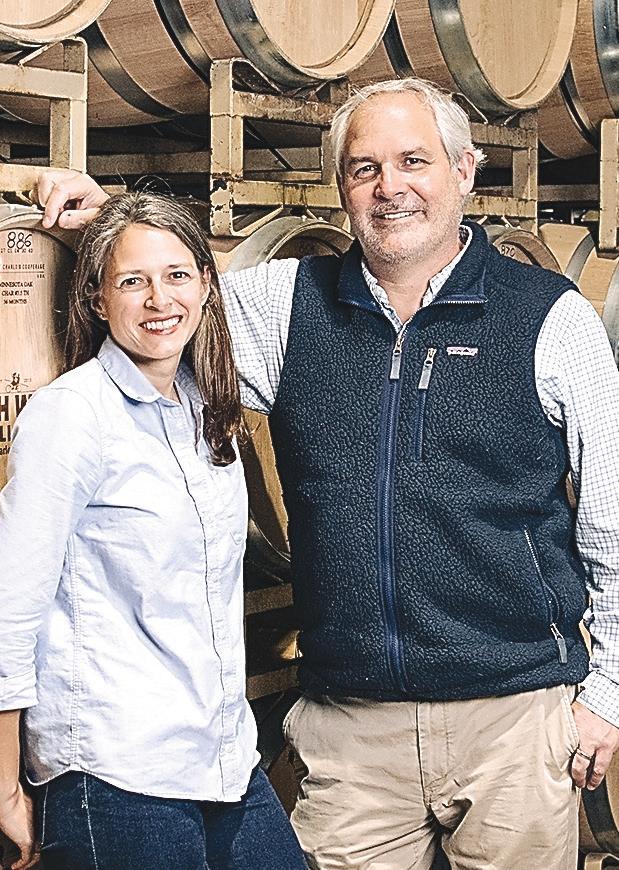 By Michael Pham
By Michael Pham
bars,” he said. “It’s a really cool experience to get a glimpse of their process, learn a little bit about the grapes, learn a little bit about how wine is made, that kind of thing.
“You can sit here at the bar in the distillery and see that happening, and get a taste of the alcohol coming right off the still and watch what you’re drinking being made.”
At the distillery, the bartenders behind the bar aren’t actually bartenders — they’re educators, Blackwell said.
“Sometimes when you go to a cocktail bar, they list out what’s in the drink, but you’re not really thinking about it,” he said. “There’s a disconnect. In the tasting



room, there’s this richer experience. It’s a different outing. Who better to tell our story than us?”
High Wire Distilling is located at 311 Huger St. and open 10 a.m. to 6 p.m. Mondays through Saturdays.
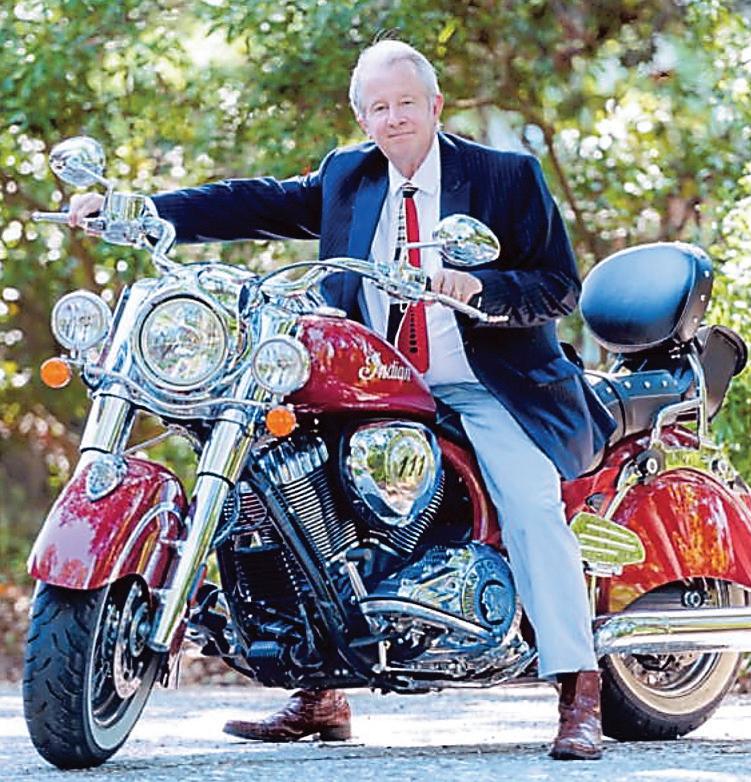
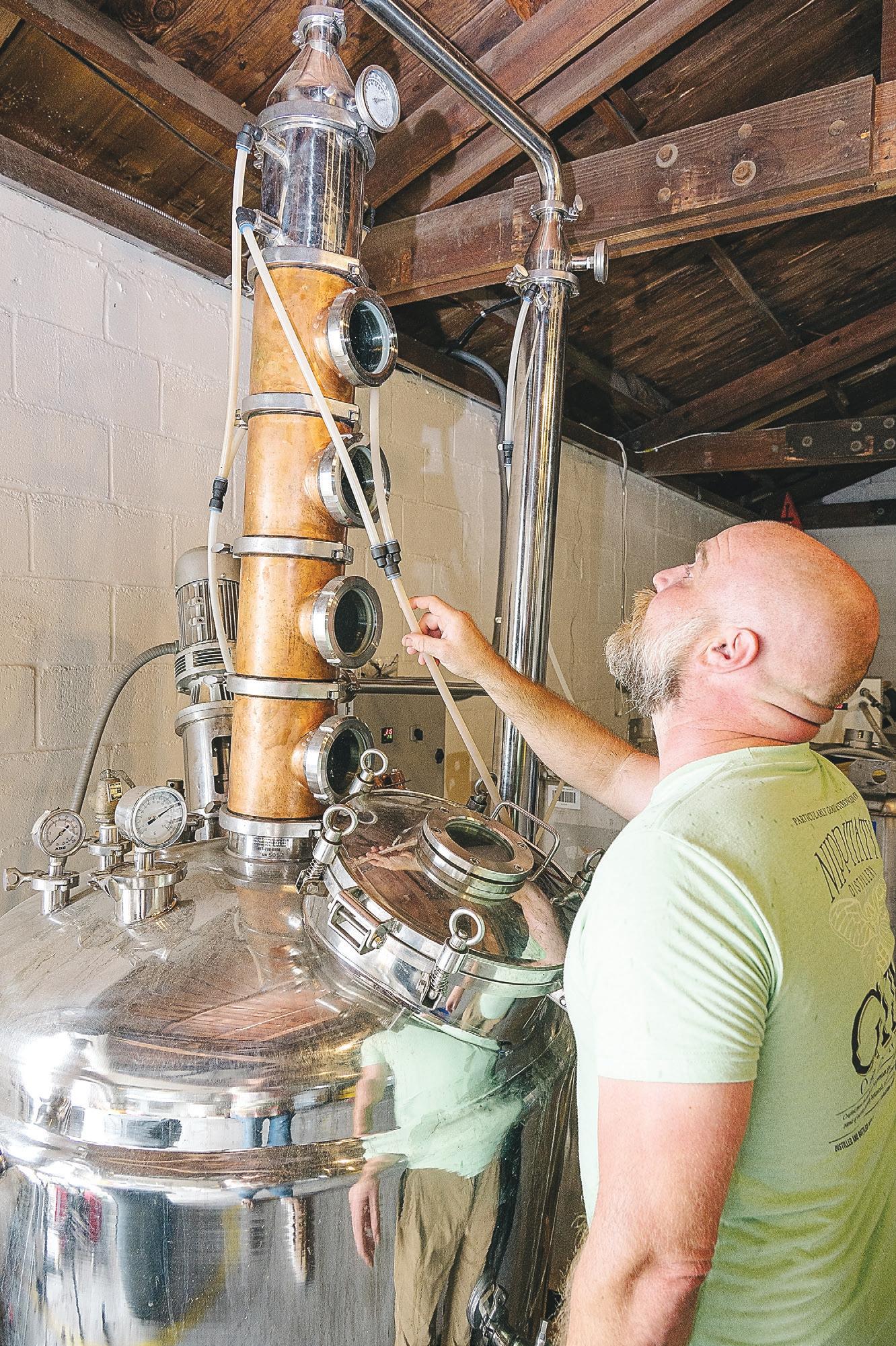
At Nippitaty Distillery in North Charleston, it’s all about highlighting the locally made gin and vodka, according to owner Traxler Littlejohn, who compares it to the rising popularity of breweries in town.
“By coming to the source instead of going to a restaurant to have a single beer pooled, you go to a brewery to see what else they have,” he said. “Same principle
for liquor. That’s the beautiful thing about it. When you come to the distillery, you are able to demonstrate the versatility of a single product.”
While breweries offer a much larger variety than Nippitaty’s spirits, Littlejohn said at the tasting room, they can make upwards of 10 to 15 different cocktails.
Nippitaty only carries the spirits they
“
When you come to the distillery, you are able to demonstrate the versatility of a single product.” —Traxler Littlejohn
make — two types of gin and one vodka — as well as several syrups and juices to make tasty cocktails that highlight the flavors of its spirits.


“If people come from out of town, they might not have ever had a brewery’s beer,” Littlejohn said. “But with liquor, we’re in various restaurants on cocktail menus, and so when you come to the distillery, you come straight to the source.”

In doing so, he said, there are several things you can take away from your time in the tasting room. You can watch and learn how to make a cocktail using Nippitaty’s spirits.
“We’ll give you an ingredient list and say, ‘Hey, take a picture,’ and show them how to make it. Then they can buy a bottle and go to the grocery store, get some limes, lemons, sugar and LaCroix [sparkling water], and they can make the
same cocktails at their house.”
You can also learn the process of distillation from Littlejohn himself with a tour of the back room.
“I always tell people if you see my truck outside, come on in,” he said.
“We’re happy to take the time to walk you through it. We might be doing a run, might be bottling, or I just might be doing admin. I love showing the process.”
Compared to restaurants or cocktail bars, hanging out in the tasting room is a much different, more relaxed vibe, Littlejohn said. He calls the tasting room a pre-game or post-game spot.
“We aren’t super busy all the time, so it’s a place where you can come and relax and have a cocktail before dinner, or come after dinner for a nightcap,” he said. And even better, you can buy a bottle straight from Nippitaty instead of retail bottle shops.
Nippitaty Distillery is located at 4405 Spruill Ave. and open from 3 p.m. to 7 p.m. Wednesdays through Thursdays and 3 p.m. to 10 p.m. Fridays and Saturdays.
Though Sweet Grass’ vodka and bourbon are distilled just a few hours away in Spartanburg, the spirits themselves are bottled and housed in its flagship Meeting Street facility at The Refinery — the Sweet Grass Lounge.
“[CEO Jarrod Swanger] made a place so when people come in to try the vodka, it would represent our company,” said manager Lindsey Drummond.

The space was designed by Olivia Brock of Torrance Mitchell Designs in Charleston, incorporating the industrial interior of The Refinery and copper exposure.
When you walk into the space, you’re greeted by a large pot still against a tiled backdrop to demonstrate how the vodka is made. The walls, painted by Emily Pope Harris, are painted to look like weathered copper to match the industrial style. The space is littered with leather-bound chairs and loveseats for comfort and style and has plenty of space to lounge around and enjoy the namesake’s vodka and bourbon.
The lounge is more than just a tasting room, though, Drummond said. Sweet Grass’ bourbon along with other spirits, liqueurs and beers are offered at the lounge, too.
“We [offer] all spirits just because we want to be a place where people can come and enjoy our vodka and also enjoy something else,” she said. “It’s mostly a place to come and enjoy cocktails and small bites.”
Snack on plates like pimento cheese fondue, Carolina barbecue lettuce


Continued on page 20
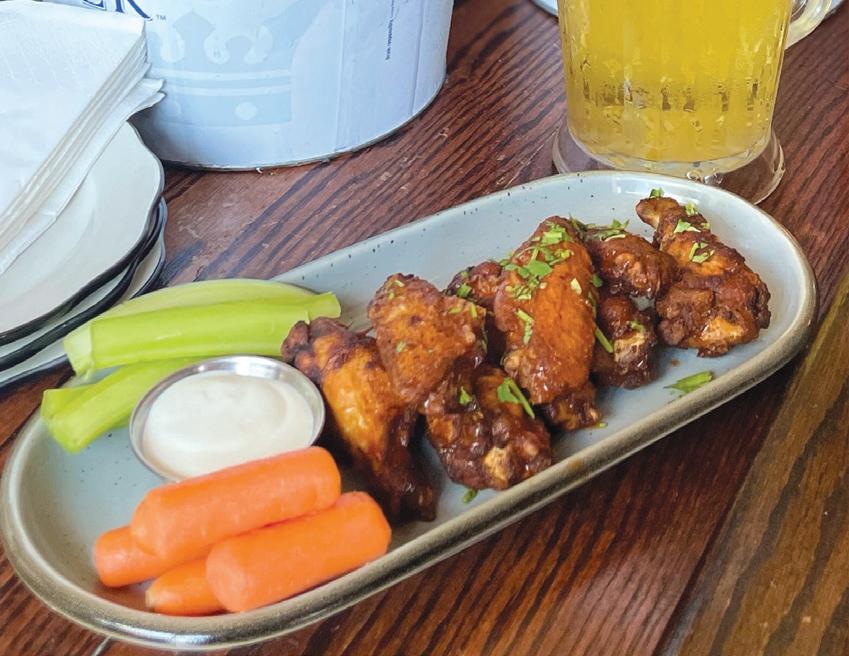

wraps, tinned seafoods or a customized cheese and charcuterie board. Brunch is available on Sundays. Food and beverage industry professionals can stop by Wednesdays for cheap drinks and food specials.
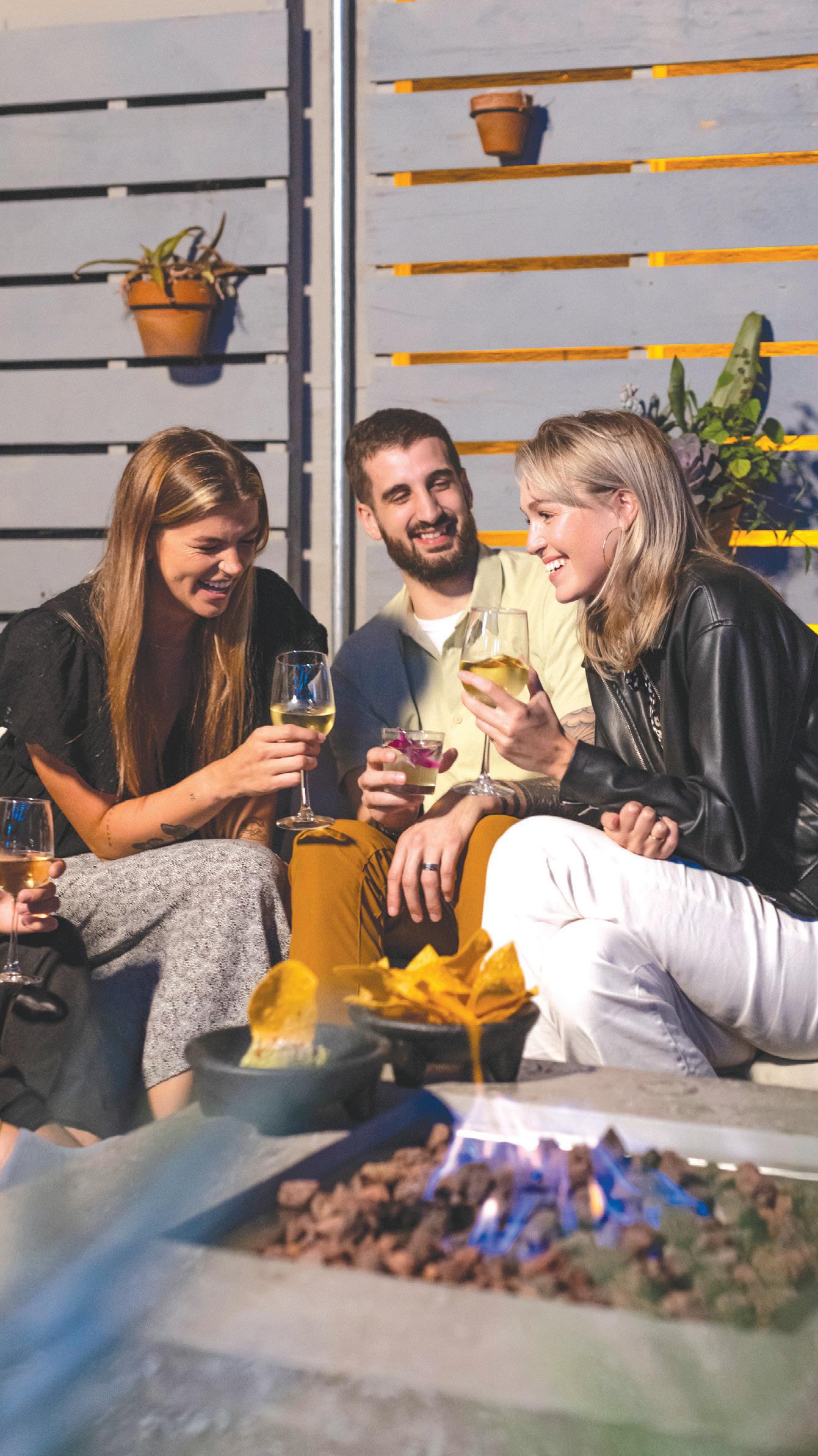


Cocktail classes are also available at the lounge, educating parties between four and 15 on the basics of bar tools, cocktail history and crafting cocktails.
“We’re here to give you a space that kind of represents the brand as soon as you walk in,” Drummond said. “And I think that we’ve done that. So I think people are
“ Their mission is rooted in community and shared experience, which is why the second I tried it, I knew I wanted to become a part of it.”
—Jeremy RennerSweet Grass Lounge at The Refinery on Meeting Street offers a relaxed atmosphere to indulge in tasty cocktails and bites Photos by Rūta Smith
able to come here, taste the vodka, hear about it, and hear the story of how we’ve gotten to where we are and even to where we’re going. I think it’s really exciting for people, and they really enjoy it.”
Recently, the brand got an even bigger boost when two-time Academy Award nominee Jeremy Renner announced July 23 on Instagram that he is now a partial owner of the Charleston-based brand. Renner’s co-ownership allows Sweet Grass to be sold nationwide, according to Drummond.
“I’m so grateful for the progress I’ve made since the start of this year which allowed me to move forward with my interest in Sweet Grass Vodka,” Renner wrote in the post. “Their mission is rooted in community and shared experience, which is why the second I tried it, I knew I wanted to become a part of it.”
Sweet Grass Lounge is located at 1640 Meeting Street Road and open from 4 p.m. to 11 p.m. Wednesdays through Saturdays and from 11 a.m. to 5 p.m. Sundays.
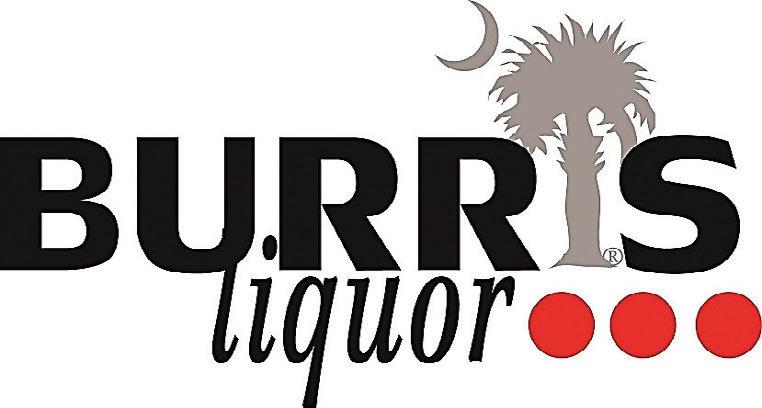
High Wire, Nippitaty and Sweet Grass aren’t the only distilleries in town. The Charleston area is home to many others as well, offering a wide variety of different flavors and spirits.

Beyond Distilling Company
2157 Rich St. North Charleston.
Open 8:30 a.m. to 4:30 p.m. Tuesdays through Thursdays.
Cannon Distillery

1750 Signal Point Road. James Island.
Open 1 p.m. to 7 p.m. Thursdays through Saturdays.

Charleston Distilling Co.
3548 Meek’s Farm Road. Johns Island.
Open 5 p.m. to 9 p.m. Mondays through Thursdays, 5 p.m. to 10 p.m. Fridays, 3 p.m. to 10 p.m. Saturdays, 3 p.m. to 9 p.m. Sundays.
Firefly Distillery
4201 Spruill Ave. North Charleston.
Open noon to 6 p.m. Mondays through Thursdays and Saturdays. Open noon to 8 p.m. Fridays.
Striped Pig Distillery
2225 Old School Drive. North Charleston
Open noon to 4 p.m. Tuesdays and Wednesdays, noon to 6 p.m. Thursdays through Saturdays.
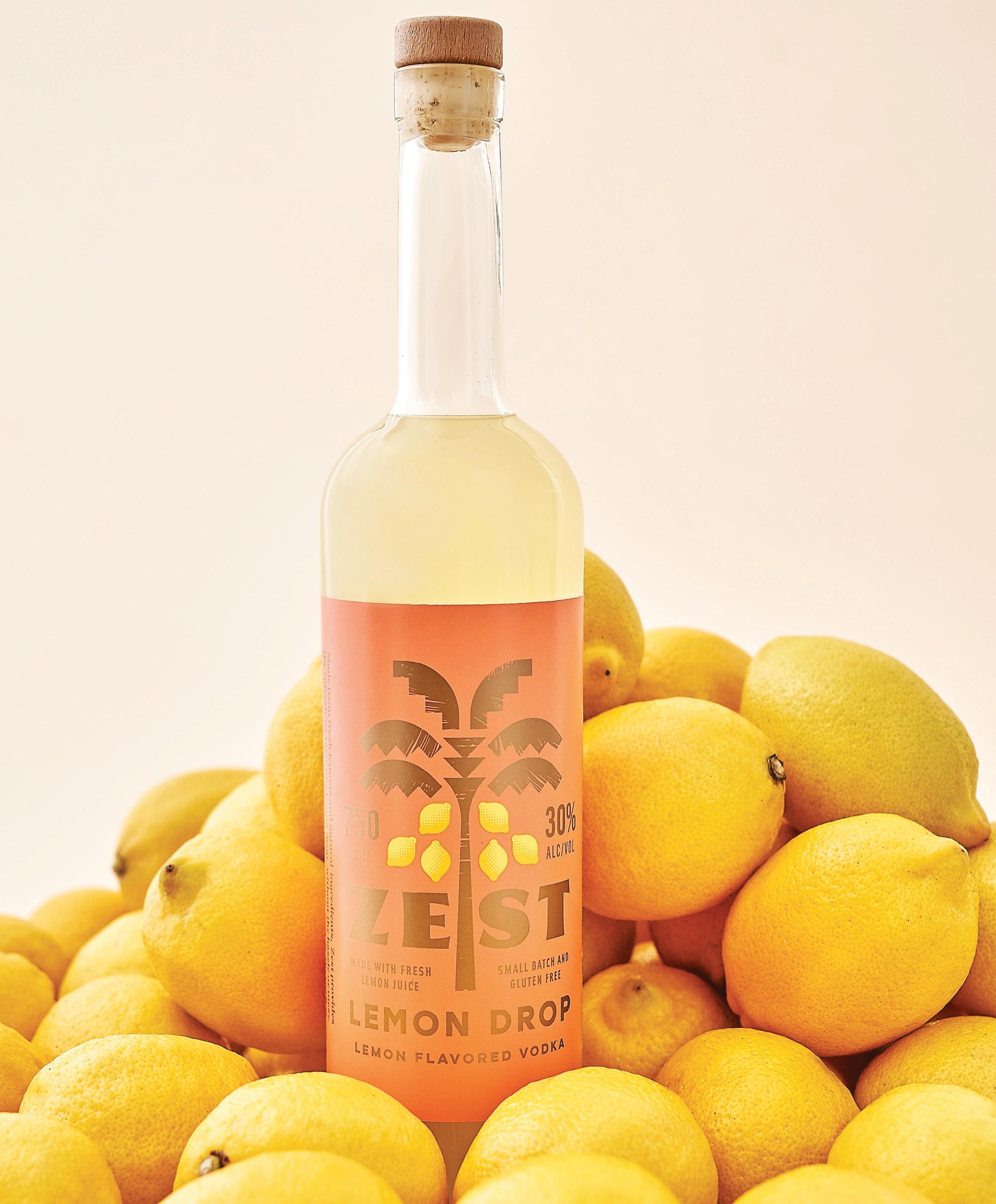 By Michael Pham
By Michael Pham
hat started as a quick post-college business endeavor turned into one of the biggest small batch spirits in the Lowcountry. But it wasn’t as easy as it sounds, according to Zest Vodka co-owner Jake MacDowell.
Zest Vodka has become one of the fastest growing liquor companies in South Carolina, available in hundreds of locations across the Southeast. The company started operations in Piedmont, South Carolina, but moved bottling operations back to Charleston earlier this year.
The company has grown rapidly since officially launching in 2021, available in more than 50 Charleston bars and restaurants like The Shelter and Saltwater Cowboys and retail stores such as Total Wine, Bottles and more.
Zest Vodka infuses the flavor of the acidic, sweet “lemon drop” shot or cocktail into its vodka. Lemon drop shots and cocktails are made with vodka, lemon juice, triple sec and simple syrup, served in a sugar-rimmed glass. While many people enjoy the taste of a lemon drop drink, MacDowell said it is notorious amongst bartenders as a tedious cocktail to make.
Zest, in its purest form straight from the bottle, is a lemon-flavored vodka with a little bit of sweetness that captures that same lemon drop flavor. It is similar to a limoncello with lighter natural flavors. It’s sweet, but not artificial in taste. MacDowell suggests mixing it with club soda and a lemon wedge to accentuate the flavors and add texture.
Continued on page 24




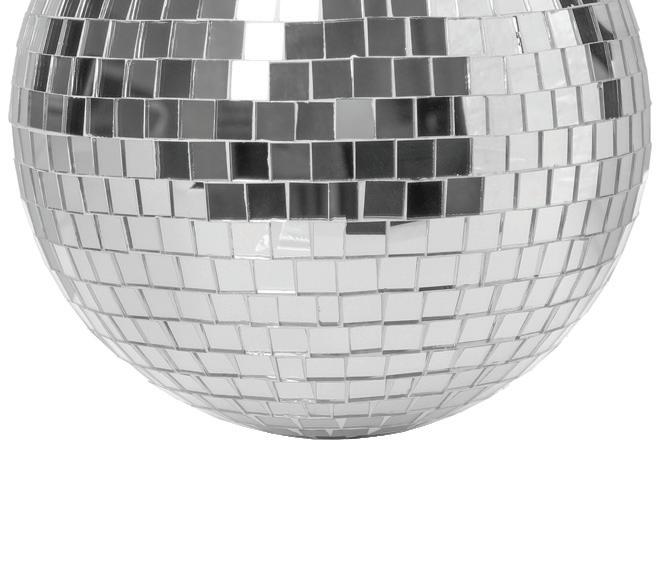












The idea behind Zest, said MacDowell, was to make it a bit easier for bartenders to make lemon drop shots or cocktails, as well as provide a cheap, tasty drink to pair with club soda or drink solo.

Before creating Zest, MacDowell developed Red Harbor Rum with his freshman year college roommate Justin Buchanan. MacDowell and Buchanan felt unsure of where their careers were headed, so they entered a school business contest in 2013 at their college, Wofford.

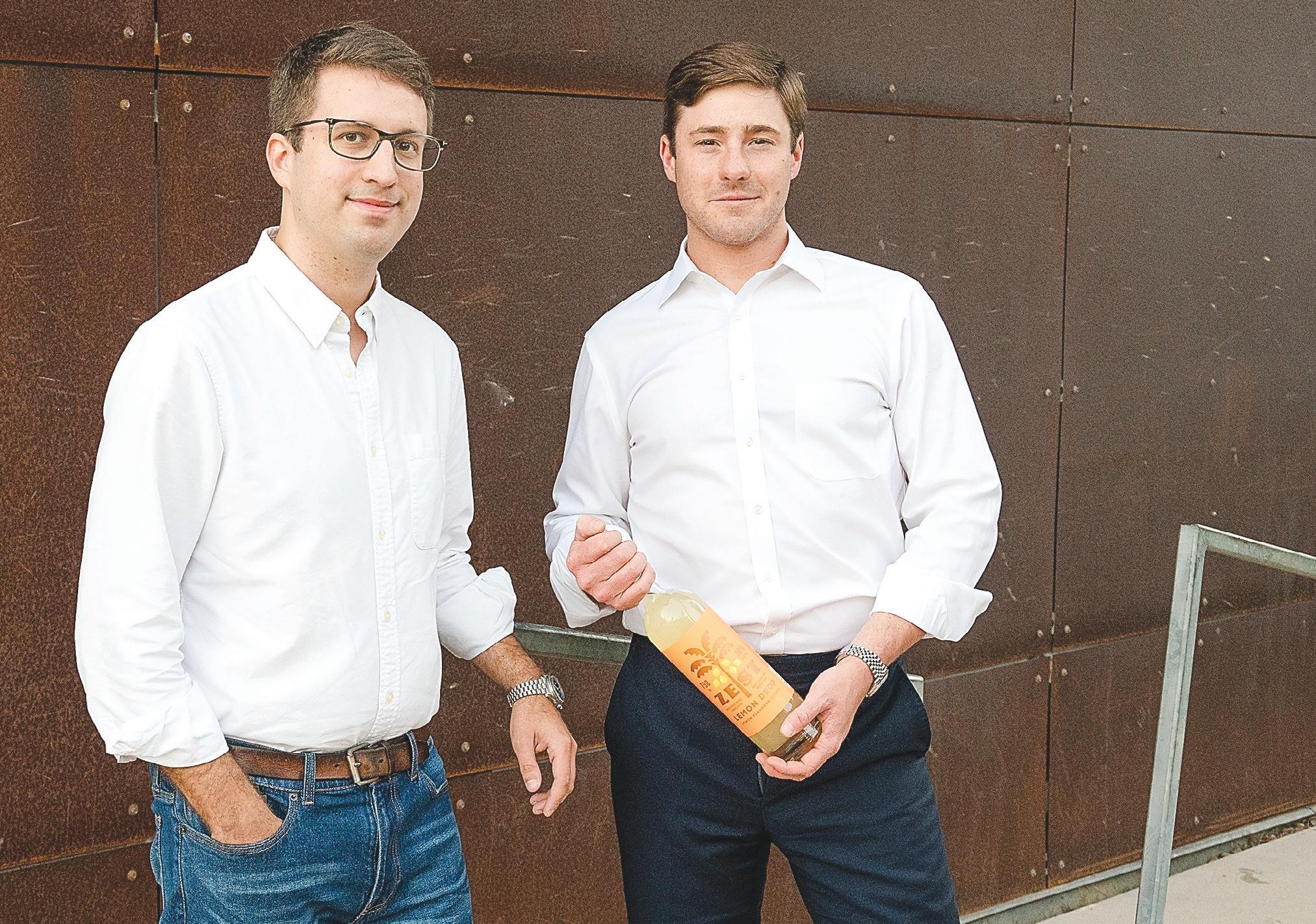
MacDowell said all he knew about the competition was that the business proposal could be on anything. That year, his family friend told him about a big boom in microdistillation. With that knowledge, he took to the internet.
“I Googled ‘Charleston history liquor’ expecting to make bourbon,” MacDowell said. “Well, it turns out, rum ran the colonies, and Charleston was a huge port. As soon as I got this idea, I called the closest distillery — which is the facility where we co-pack Zest now — and I go, ‘How the hell do I make liquor?’ ”
After class every day, MacDowell would go to the distillery and learn how to make rum. After college, when
Continued on page 26







MacDowell and Buchanan were granted funds from the business program competition, they opened a distillery off of Ashley Phosphate Road in North Charleston called Port City Distillery to make Red Harbor Rum.

“I was in the rum business and 23 years old,” MacDowell said. “But what I found was that it doesn’t matter how good the rum is, it doesn’t matter how good the packaging is, some of these old guys who are 60 years old don’t want a 23-year-old coming to him saying, ‘Hey, I’m a young entrepreneur.’ ”
Buchanan planned to start a new business venture.
“I knew when it came to the second product, I wanted something that wasn’t so serious,” MacDowell said. “Something light, fun, refreshing and around $20 for a bottle but also still keep it natural.”

While trying to come up with a new idea, MacDowell was at The Shelter in Mount Pleasant talking with a bartender and throwing ideas out on what kind of product he should make. The bartender, in jest, suggested making a lemon drop shot so “he wouldn’t have to make them all for these bachelorette parties,” MacDowell recounted.
That conversation wasn’t the initial lightbulb idea for Zest, he added, but it allowed him to approach the situation in a specific way, saving time and money and getting restaurants the most bang for their buck. For research, he went to nearly two dozen bars, timing bartenders on how long it took to make a lemon drop shot. He realized that with a lemon-flavored vodka, he could save bartenders, on average, about a minute and a half.
He also added that trying to get the small batch $40 rum into stores and bars wasn’t an easy task. After several years of building the brand and bringing it into seven different states, MacDowell and

After using what he learned from distilling and marketing rum and working with the same co-packer from Red Harbor, MacDowell and Buchanan launched Zest Vodka in summer 2021 at Uptown Social.

“
I knew when it came to the second product, I wanted something that wasn’t so serious.” —Jake MacDowell








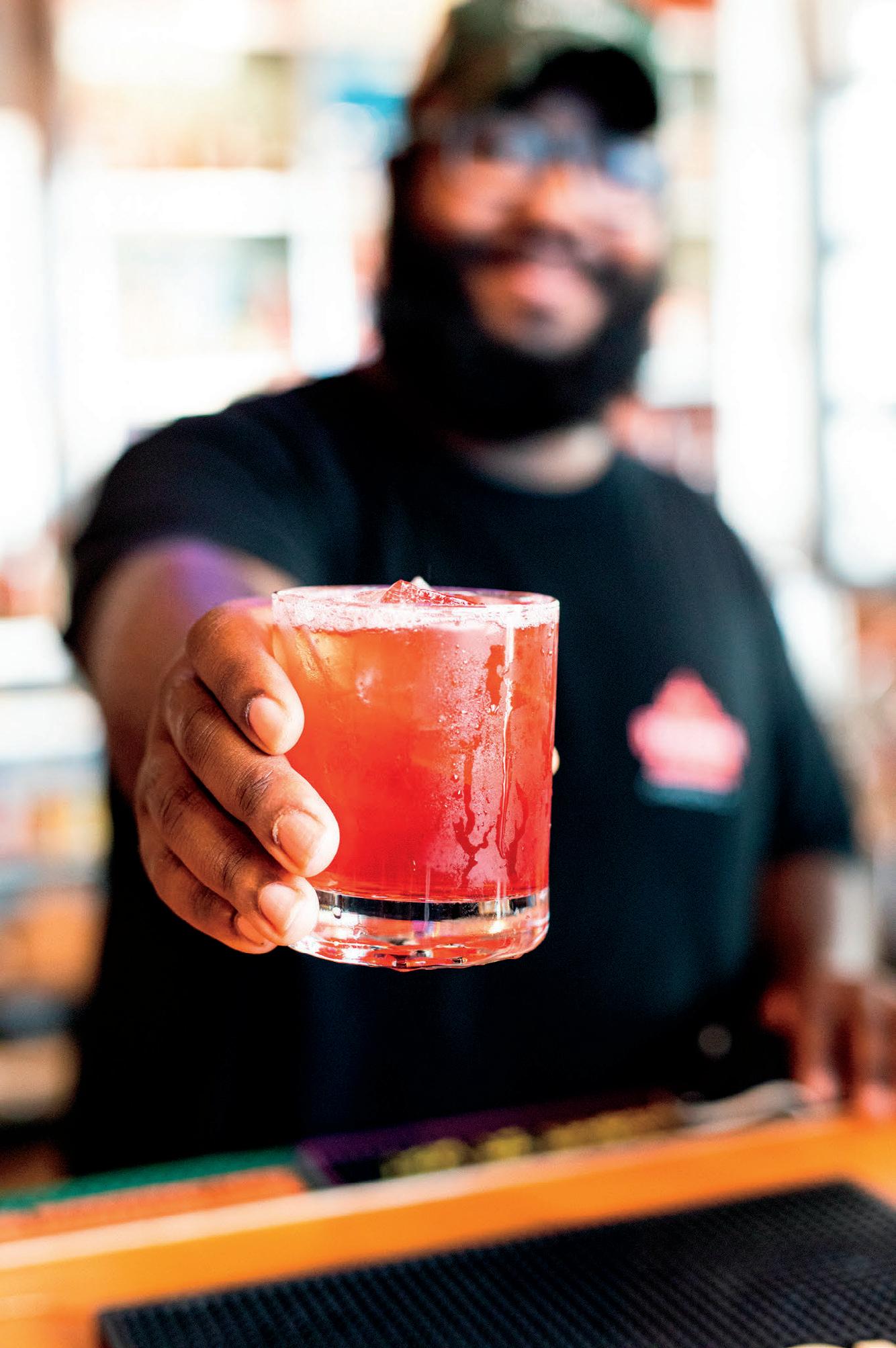


Charleston’s hot summer days and warm fall evenings are perfect for sipping something cool and refreshing, like a light, bright wine. But with so many options, it can be tough to choose the right summer wine for each occasion. We caught up with Garth Herr, sommelier and general manager of The Royal Tern on Johns Island, for tips on how to choose the perfect summer sipper.

City Paper: What types of wine do you recommend drinking in the summer?
Garth Herr: The short answer for me is Champagne, but, since I can’t afford that every day, I gravitate towards lighter, lower alcohol wines. It’s hot out, and they are more refreshing. Whites, I usually go with dry, crisp, mineral-driven styles. I love dry Riesling, Grüner Veltliner and Chardonnay from Chablis. There are tons of smaller producers with more obscure varietals that definitely make their way into the rotation.
Reds, I love Cabernet Franc from Loire and Gamay from Beaujolais, but there are fun things coming out from all over that have adopted a more refined style. The trend towards brighter, lighter wines appeals very much to my palate. Between, Cinsault, Trousseau, Zweigelt, some Grenache, etc., we really do have endless chances to try something new and fresh.
CP: Most people associate whites and rosés with summer. What about chilled reds?
Herr: Absolutely — chilled reds are an essential part of summer! We have a few on our menu as well. Burgers and barbecue are classic summer time, and I generally enjoy red with them (whites work too), but in the heat, the chill makes it so much more refreshing.
CP: Do different wines work better for different scenarios?
Herr: Definitely. I even pair different wines based on different moods. On a boat? Rosé.
At the beach, I like Fino Sherry (I love
the brininess paired with the salty air). Playing Bocce or other games during which the wine is getting warm from carrying it around, I want light, easy white. These activities are all at the beach but are different wine moods.
Am I sitting on the porch alone, with my family or with friends? Alone, I’ll probably think about the wine more, so I would want something worth contemplating. With the family, we just like to try something new. With friends, it would be rosé (or Aperol spritz) in the afternoon, then maybe light red.
CP: The general rule of thumb is that you drink red wine with red meat and white wine with fish. Is this an outdated rule?
Herr: Definitely outdated. It is a simple rule that’s easy to remember, but there are so many options. Salmon and tuna can definitely stand up to red. I love Champagne with filet mignon, especially if it has a rich sauce like hollandaise. Every dish can be changed based on sauces, sides and accompaniments. The protein is just one small part of the pairing.
The reality is, rarely does a table all order the same dish, so when pairing, I’m actually thinking of what goes with the halibut, the tuna and the ribeye, or what will go with the first course of raw oysters yet still carry over to the second course of beef tartare?
CP: What’s your wine of choice in the summer?
Herr: Muscadet. They can be as simple as pinot grigio or as complex as Chablis 1er Cru at a fraction of the price. I think the name sounds similar to moscato or muscadine so people think they are sweet. I assure you, if you buy a bottle of muscadet, it will taste nothing like those.
Other than that, it changes every year. Some of this year’s go-tos have been Gatto Arancio (an Orange Verdicchio), Punta Crena Lumassina (a still wine with trapped CO2 that makes it spritzy), Manuel Moldes ”Afelio” Albariño and Schödl “Rote Erde” Dry Riesling.
PETE BERNHARD OF THE DEVIL MAKES

THREE CLYDE MCGEE LIGHTNING LUKE OF THE BRIDGE CITY SINNERS

Saturday, Aug. 26 at 8 p.m. at Tin Roof
HOMEGROWN AT THE POINT 2023

Through Friday, Sept. 8 at Charleston Harbor Resort & Marina
COCKTAILS FOR A CAUSE
Tuesday, Oct. 10 6 p.m. - 8 p.m. at Harbour Club at Westedge
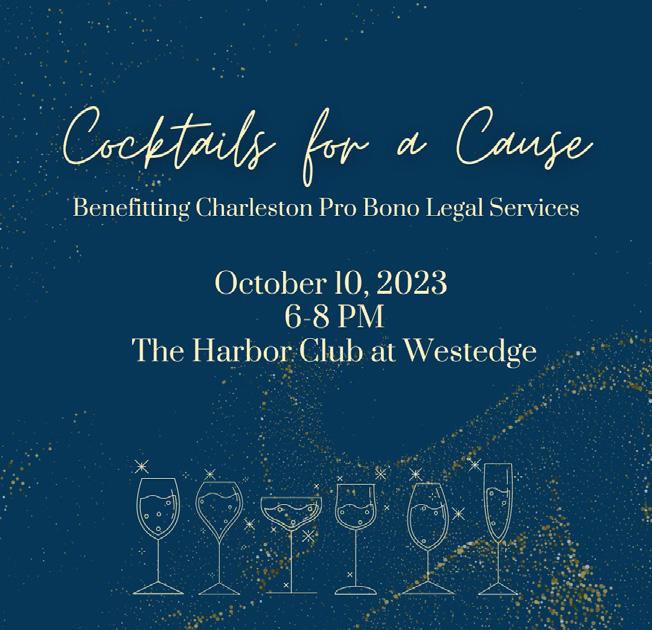
event
HAUNT W/ HELL FIRE

Tuesday, Sept. 5 at 8 p.m. at Tin Roof
DIRTY ROTTEN IMBECILES
Sunday, Sept. 17 at 7 p.m. at Tin Roof • 21+
2023 CHARLESTON LITERARY FESTIVAL EARLY BIRD ALL SESSION ACCESS PASS
Friday, Nov. 3 through Sunday, Nov. 12 Multiple Locations

WITH SPECIAL GUESTS THE WILD FEATHERS, INTO THE FOG, & MOLLY DURNIN

60 + BREWERIES 20 + FOOD TRUCKS

30 + CRAFT VENDORS GAMES & MORE!!
*ALL PROCEEDS BENEFIT PALMETTO COMMUNITY CARE*
Powered By: